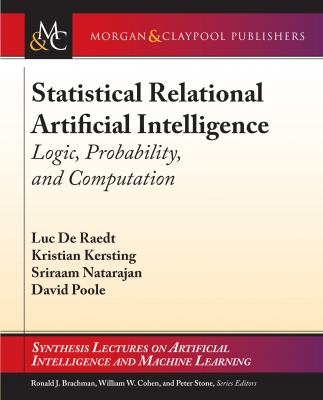Statistical Relational Artificial Intelligence. Luc De Raedt
Чтение книги онлайн.
Читать онлайн книгу Statistical Relational Artificial Intelligence - Luc De Raedt страница 3
 4.1 Knowledge Representation Formalisms
4.1 Knowledge Representation Formalisms
4.2 Objectives for Representation Language
4.3 Directed vs. Undirected models
4.4 First-Order Logic vs. Logic Programs
4.5 Factors and Formulae
4.6 Parameterizing Atoms
4.7 Aggregators and Combining Rules
4.8 Open Universe Models
4.8.1 Identity Uncertainty
4.8.2 Existence Uncertainty
4.8.3 Ontologies
5 Inference in Propositional Models
5.1 Probabilistic Inference
5.1.1 Variable Elimination
5.1.2 Recursive Conditioning
5.1.3 Belief Propagation
5.2 Logical Inference
5.2.1 Propositional Logic, Satisfiability, and Weighted Model Counting
5.2.2 Semiring Inference
5.2.3 The Least Herbrand Model
5.2.4 Grounding
5.2.5 Proving
6 Inference in Relational Probabilistic Models
6.1 Grounded Inference for Relational Probabilistic Models
6.1.1 Weighted Model Counting
6.1.2 WMC for Markov Logic
6.1.3 WMC for ProbLog
6.1.4 Knowledge Compilation
6.2 Lifted Inference: Exploiting Symmetries
6.2.1 Exact Lifted Inference
6.3 (Lifted) Approximate Inference
7 Learning Probabilistic and Logical Models
7.1 Learning Probabilistic Models
7.1.1 Fully Observed Data and Known Structure
7.1.2 Partially Observed Data with Known Structure
7.1.3 Unknown Structure and Parameters
7.2 Logical and Relational Learning
7.2.1 Two Learning Settings
7.2.2 The Search Space
7.2.3 Two Algorithms: Clausal Discovery and FOIL
7.2.4 From Propositional to First-Order Logic
7.2.5 An ILP Example
8 Learning Probabilistic Relational Models
8.1 Learning as Inference
8.2 The Learning Problem
8.2.1 The Data Used
8.3 Parameter Learning of Relational Models
8.3.1 Fully Observable Data
8.3.2 Partially Observed Data
8.3.3 Learning with Latent Variables
8.4 Structure Learning of Probabilistic Relational Models
8.4.1 A Vanilla Structure Learning Approach
8.4.2 Probabilistic Relational Models
8.4.3 Boosting
8.5 Bayesian Learning
9 Beyond Basic Probabilistic Inference and Learning
9.1 Lifted Satisfiability
9.2 Acting in Noisy Relational Worlds
9.3 Relational Optimization
Preface
This book aims to provide an introduction that can help newcomers to the field to get started, to understand the state-of-the-art and the current challenges and be ready for future advances. It reviews the foundations of StarAI, motivates the issues, justifies some choices that have been made, and provides some open problems. Laying bare the foundations will hopefully inspire others to join us in exploring the frontiers and the yet unexplored areas.
The target audience for this book consists of advanced undergraduate and graduate students and also researchers and practitioners who want to get an overview of the basics and the state-of-the-art in StarAI. To this aim, Part